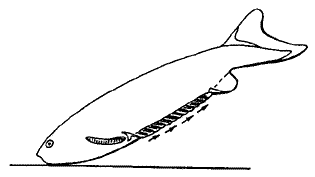
| Palaeos: |  |
Anaspida |
| The Vertebrates | Anaspida |
| Page Back | Unit Home | Unit Dendrogram | Unit References | Glossary | Page Next |
| Unit Back | Vertebrates Home | Vertebrate Dendrograms | Vertebrate References | Bones | Unit Next |
|
Abbreviated Dendrogram
Chordata | Craniata |--Myxinoidea `--Vertebrata |--Jamoytiiformes `--+--Hyperoartia (= Petromyzontiformes) `--+--Conodonta `--+--Anaspida | |--Pharyngolepis | `--+--Pterygolepis | `--Rhyncholepidida `--+--Pteraspidomorphi |--Thelodonti `--+--Cephalaspidomorphi `--Gnathostomata |
Contents
|
 |
| Pterygolepis. Wenlock (late Silurian) of south-east Euramerica. Length 10 to 15 cm. Graphic from Faktaside om fossile urfisk fra Norge, © 1998 Paleontologisk Museum - University of Olso. |
The Anaspida lack the extensive bony plates of their ostracoderm cousins. These jawless fishes had a laterally-compressed scale-covered body. They range from Early Silurian to the Latest Silurian, and are limited to the Euramerica Province. All were quite small, about 10 or 15 cm in length.
The genera Jamoytius, from the Early to Middle Silurian of Scotland, and Endeiolepis, Euphanerops and Legendrelepis, from the Late Devonian of Quebec, are traditionally referred to as anaspids by, among other features, their strongly hypocercal tail, a characteristic which is now known to occur in other vertebrate groups (e.g. thelodonts). Janvier argues that they are apparently more closely related to the lampreys.
The Anaspida are all narrow-bodied jawless vertebrates characterized by triradiate postbranchial spines. They possess rod-like body scales (when not naked), large median dorsal scales or scutes, broad-based paired fins, and a strongly hypocercal (downward- lobed) tail. Their exoskeleton (scales, dermal plates) are made up of acellular bone (aspidin). They may have been awkward, inefficient swimmers, since they lacked the basic stabilizing fins of
 An interpretation of the paired fins of the anaspid Pharyngolepis as a slow displacement device (arrows indicate the direction of the undulation of the fin). Illustration from Janvier (1996). |
 |
| Stratigraphic range and cladistic relationships of the Paleozoic Anaspida and related forms: L = Lower (Early), M = Middle, U = Upper (Late), Q - Jamaytius; R - Legendrelepis; S - Endelolepis; T - Pharyngolepis; U - Pterygolepis; V - Birkenia; W - Lasanius; X - Phlebolepis; Y - Loganellia. Diagram from Janvier & Blieck (1993) |
Their feeding method was probably to plough through the bottom sediment, head-first, scooping up tiny food particles into the small, rounded mouth.
Anaspids are rare as fossils and are apparently restricted to the Silurian. The earliest record consists of isolated scales from the Llandovery of Arctic Canada, and the latest from the Late Silurian of the Baltic area. The Anaspida occur mostly in Norway and Scotland, with some sparse records from eastern Canada, the Baltic area, and a single perhaps dubious record of a "birkeniid" from China.
One of the possible phylogenies of the Anaspida suggests a tendency towards the reduction of the number of gill openings, enlargement of the median dorsal scutes, reduction of anal fin, but is neither corroborated nor refuted by stratigraphy, since most anaspid taxa are of the same age. MAK000113.
Range: Silurian.
Phylogeny: Vertebrata::: (Pteraspidomorphi + Thelodonti + (Cephalaspidomorphi + Gnathostomata)) + * : Pharyngolepis + (Pterygolepis + Rhyncholepidida).
Characters: 15 cm. Minnow-like, slender with no head shield; some naked; upper & lower margins of round mouth bore dermal bones which may have been used a sort of dentition; orbits large & surrounded by dermal bone, but sclerotic ring absent; single medial pineal and hypophyseal openings; 6-15 gill openings (trend is reduction of #), usually in a slanting line, behind orbits; $ at least one large, tri-radiate spine behind the series of the gill openings; body covered in elongated scales arranged in chevrons which may reflect underlying myomeres (if so, body musculature extended far ant, perhaps overlapping gills); anal fin usually in far post; primitively, pectorals extended from gills to anal fin; muscles & radials for pectorals inferred from scale structure; no dorsal or separate pelvic fins, but dorsal scutes common & trended to larger, curved or hooked shapes; strongly hypocercal tail, but with large dorsal fin web (possibly this is dorsal fin); acellular, laminar bone similar to aspidine; no dentine & no enameloid caps. Relationship to Petromyzontiformes and to Devonian forms unclear.
Links: Anaspid model ; Anaspid cast; Geol 437 jawless fishes; Anaspida. ATW040314.
Range: Silurian of Europe
Phylogeny: Anaspida: (Pterygolepis + Rhyncholepidida) + *.
Characters: Head covered with relatively large scales compared to other anaspids; distinctive keeled oral plate on ventral surface just under mouth; about 15 branchial openings in postero-ventrally slanting line, terminating in tri-radiate spine diagnostic of anaspids; elongated body; median dorsal ridges small; no dorsal fin (as all anaspids); anal fin present and posteriorly placed; long ventrolateral "fin-fold" from branchial spine to anal fin; "fin-fold" apparently lacks fin rays and perhaps musculature; folds covered with minute scales in thin rows with thicker basal row of scales.
Links: Pharyngolepis oblongus; Annual Conference Abstracts 1999; Anaspida; Volume 16 (V2); Fiskarnas evolution.
Note: believed to be primitive form based on (a) unreduced anal fin (b) relatively large number of branchial openings (c) small dorsal ridge scales. Overall appearance strongly reminiscent of classical thelodonts, but scale histology is supposedly distinct. ATW040314.
Range: Late Silurian (Ludlow).
Phylogeny: Anaspida:: Rhyncholepidida + *.
Characters: "branchial band" of gill openings angled at ~35° from horizontal; <25 dorsal ridge scales.
Links: Pterygolepis nitidus; Anaspida; PPT Slide; Timeline of a Pale Blue Dot; SILURIANO (Spanish). ATW040314.
See also life reconstruction
 Rhyncholepidida:
Rhyncholepis.
Rhyncholepidida:
Rhyncholepis.
Range: Silurian
Phylogeny: Anaspida:: Pterygolepis + *.
Characters: $ Reduced anal fin; $ Shortened paired fins; $ Large median dorsal scutes.
Links: Anaspida. ATW 040314.
| Page Back | Unit Home | Page Top | Page Next |